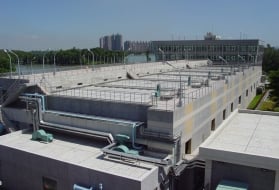groundwater
Reading time:origins
Groundwater is held in terrain that acts as a reservoir and designated aquifer.
The terrain’s porous nature and structure will determine the type of aquifer and underground circulation conditions.
Groundwater can be free (or a phreatic aquifer when it is sufficiently close to the surface to be accessible via a well). In this case, the groundwater is fed directly by rainwater infiltration. This groundwater level will vary depending on the amount of water held in the aquifer.
Alluvial water represents a special case; this water can be found in alluvial terrains crossed by a waterway. Alluvial water quality will then be directly affected by the quality of the river water.
Groundwater can be confined when it is trapped between two layers of impermeable terrain; this is the most frequently occurring ground water and will generally be the deepest; this water is subject to a certain pressure: its hydraulic level is normally positioned between an impermeable roof and the ground surface; it is designated artesian when this level is above the ground surface (creating a water jet when sinking a drilling).
Water can either impregnate the entire geological stratum concerned: this is the case of porous terrain such as sand, sandstone and alluvia; alternately, groundwater may occur exclusively in compact rock fractures or cracks.
This is the case of metamorphic or igneous rocks and of limestone terrains; in the latter, the original cracks gradually widen as the structure is dissolved by water containing carbon dioxide that circulates through this material; this process leads to immense caverns and, at times, to the formation of networks constituted of true underground rivers; this is the karstic structure.
general features
A terrain’s geological features have a determining effect on the chemical composition of the water contained in the terrain. Water is constantly in contact with the terrain where it is either standing or circulating. A balance is reached between the composition of the terrain and that of the water. Water circulating through sandy or granite subsoil will be acid and have a very low mineral content. Water circulating through limestone soils will have a calcium carbonate alkalinity and will often have a high hardness.
Table 1 provides groundwater properties based on the main analytical parameters. In particular, the following needs to be noted: good bacteriological purity, low turbidity, constant temperature and chemical composition, virtually no oxygen likely to give rise to unwanted reduced elements.
Karstic water can produce abrupt changes in quality with the appearance of various levels of turbidity and pollution. These fluctuations are linked to pluviometry and runoff water drawn off without any real infiltration occurring in the underground system.
potability
However, for a long time, groundwater has been synonymous with "clean water" that naturally satisfies potability standards. In effect, this water is less sensitive to accidental pollution.
Nevertheless, much groundwater is "influenced" by the quality of surface water. As we have already seen, this is the case of karstic water and also of alluvial groundwater.
When a water table has been polluted, it will be difficult to reinstate its original purity: in effect, the pollutants that have contaminated the water table are present not only in the water but will also have been absorbed by the rocks and minerals in the subsoil.
Groundwater can also contain elements in concentration levels that grossly exceed potability standards. This is caused by storage terrain composition and, for some of these elements, by the reducing properties of the water. For instance Fe, Mn, NH4, H2S…
Groundwater must always be treated prior to being distributed whenever the concentration of any one of these elements exceeds the figures authorised by current regulations.
mineral water, spring water and table water
French legislation identifies 3 types of water that can be bottled.
Mineral water is deep water that may contain some elements in concentrations that are higher than those approved for drinking water and that are endowed with acknowledged therapeutic properties. This water is distributed in bottles, sometimes after having undergone clearly established treatment such as: natural sedimentation, iron removal through simple aeration and filtration through sand, removal and/or re-injection of the original CO2.
In principle,unlike mineral water, spring water must fulfill potability criteria at its point of emergence and must not require any processing; however, certain margins apply with regard to the removal of some unstable elements such as dissolved iron, using the same natural means as for mineral water.
Separate from these two types of water, we have the term "water rendered potable through treatment" ( previously designated "table water"). This category refers to bottled water that only has to satisfy potability standards, preliminary treatment being authorised.
Bookmark tool
Click on the bookmark tool, highlight the last read paragraph to continue your reading later













